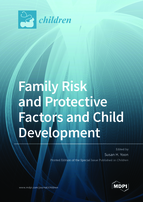Family Risk and Protective Factors and Child Development
A special issue of Children (ISSN 2227-9067). This special issue belongs to the section "Global and Public Health".
Deadline for manuscript submissions: closed (20 February 2022) | Viewed by 59501
Special Issue Editor
Special Issue Information
Dear Colleagues,
The family is the first and often the most vital environment for child development. Given that the family is the child’s first and primary social group, it is likely that the child’s learning, behavior, socialization, and development are highly influenced by their family. The presence of risk factors in families, such as family violence, child maltreatment, parental substance use, family conflict, poverty, and parenting stress may threaten child wellbeing. However, it is equally important to note that protective factors and strengths in families can promote healthy, resilient, and positive child development, despite family adversity.
Although there is a growing body of research on family risk and protective factors, much remains to be learned about the ways in which various family risk and protective factors interact with each other to shape child development over time. Further, we need to better understand how the effects of family risk and protective factors on child development may vary based on child and family characteristics, such as the child’s age, sex, race/ethnicity, family structure, and immigration status.
This Special Issue will be devoted to understanding the unique and combined effects of family risk and protective factors on child development across multiple dimensions of functioning (e.g., physical, mental, emotional, behavioral, social, cognitive). Example topics include gender differences in the effects of family risk and protective factors on child development, family risk and resilience during COVID-19, ways in which racism and oppression have contributed to differences in family risk factors, differential impact of family factors across developmental stages of children (e.g., infancy, early childhood, adolescence), cumulative risks in families, poly-strengths in families, long-term effects of family risk and protective factors, and cutting-edge interventions to promote family strength and child wellbeing. Both reviews and original research (qualitative, quantitative, and mixed-methods studies) will be considered for publication.
I look forward to receiving your contributions.
Warm regards,
Prof. Dr. Susan H. Yoon
Guest Editor
Manuscript Submission Information
Manuscripts should be submitted online at www.mdpi.com by registering and logging in to this website. Once you are registered, click here to go to the submission form. Manuscripts can be submitted until the deadline. All submissions that pass pre-check are peer-reviewed. Accepted papers will be published continuously in the journal (as soon as accepted) and will be listed together on the special issue website. Research articles, review articles as well as short communications are invited. For planned papers, a title and short abstract (about 100 words) can be sent to the Editorial Office for announcement on this website.
Submitted manuscripts should not have been published previously, nor be under consideration for publication elsewhere (except conference proceedings papers). All manuscripts are thoroughly refereed through a single-blind peer-review process. A guide for authors and other relevant information for submission of manuscripts is available on the Instructions for Authors page. Children is an international peer-reviewed open access monthly journal published by MDPI.
Please visit the Instructions for Authors page before submitting a manuscript. The Article Processing Charge (APC) for publication in this open access journal is 2400 CHF (Swiss Francs). Submitted papers should be well formatted and use good English. Authors may use MDPI's English editing service prior to publication or during author revisions.
Keywords
- family
- risk factors
- protective factors
- promotive factors
- resilience
- child development
- child wellbeing
- childhood
- adolescence







